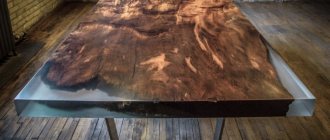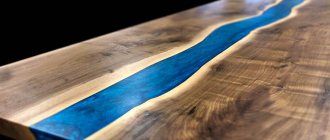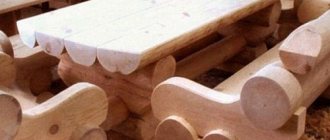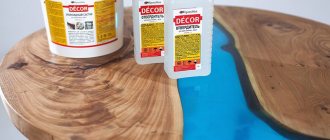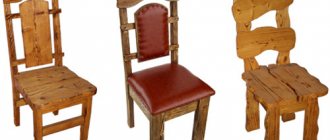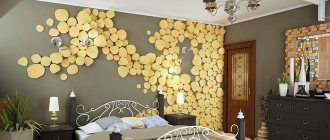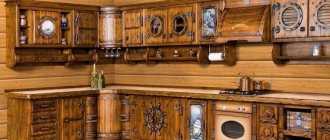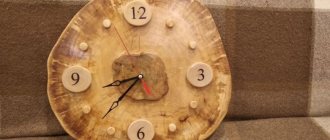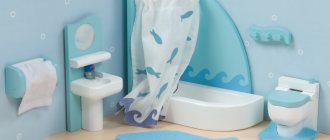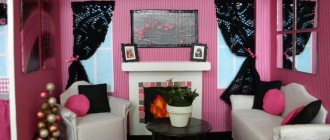The sheen of the gloss, the unique execution - it’s already interesting! Furniture made of epoxy resin combines these qualities. If you look at tables, chairs and other such furniture, you will not find two identical pieces, they are all unique. One secret lies in the author’s imagination, the other in the use of unusual materials and wood. The latter is generally unique from nature.
Epoxy resin blurs the boundaries of wood use. Thanks to it, the widest slabs are often used to make countertops. A slab is a longitudinal section across the entire width of the trunk, often reflecting the profile of the tree.
Harmony of wood and glass
Furniture made of wood and epoxy resin is a composition in which the creations of nature and man are harmoniously intertwined. The unique wood pattern in combination with colored or transparent resin, polished by human hands to a perfect shine, more reminiscent of new glass, will not leave anyone indifferent.
The noble mahogany wood and blue epoxy glass on this table model create a unique design.
Some useful tips
You can find material for original furniture in the forest, on the banks of a river, or the sea. Find a fallen tree, driftwood, driftwood. Any surviving part of a shape that interests you can be useful: a trunk with individual branches, a stump, large driftwood roots. Select the necessary raw materials and begin preparing them.
- First of all, it should be washed, cleaned of dirt,
- Remove the bark from the material. Remove rotten or rotten areas. Do this outside, looking carefully to make sure there are no pests in the wood.
If you have an idea on how to create a table foot, hanger, or other product from branches and driftwood, at this stage slightly adjust the shape of the thinner parts. To do this, fix the position of the branches you need.
- Leave clean material in a well-ventilated area to dry.
- Cut off any excess parts. Cut the pieces to the required size.
Cutting epoxy resin furniture
Sometimes, according to the author's idea, epoxy furniture looks like jewelry. Some of them were not only ground and polished, but also cut.
A stump enclosed in a glass cube, as in the photo, has wide capabilities and can perform several functions at once:
- You can admire such beauty, in which the author managed to combine the ideal with the imperfect, for hours
- you can sit on it or use it as a coffee table,
- and of course, they can decorate the interior of the living room to the delight of all guests.
Which epoxy to choose?
If you have already decided on the type, type, design of the future countertop, now it is important to decide on the choice of epoxy resin. Epoxy resin for pouring the countertop must be transparent and have a long life, otherwise you risk seeing the resin “boiling” with your own eyes or spending several times more more time for layer-by-layer filling. Structural and base resins (such as ED-20) are not appropriate here, because
they are thicker, which will not allow all the air bubbles to escape, they are more fragile, not always colorless (grade 1), and the hardeners that are used with such resins (pepa, theta, etc.) will give you a mixture with insufficient life time, which again It can also lead to both deformation of the product during rapid curing and boiling of the mixture.
Of the resins presented in our store, the EpoxyMaster 2.0 composition will suit you, allowing you to fill layers up to 5 cm in one layer. The composition has a low viscosity, provides good fluidity and filling of hard-to-reach areas, and moderate reactivity allows you to work with large objects. In addition, the EpoxyMaster composition has excellent self-leveling, resistance to peeling and cracking, good fillability and no “whitening” effect of the coating.
Thanks to the transparency of the composition, you can achieve almost any visual effect: pour in various fillers (shells, dry leaves, stones, pictures, etc.), you can organize lighting both in the thickness of the tabletop and under it, you can realize a creative idea with a phosphor or color the resin, while maintaining the overall transparency of the layer.
Furniture reconciling opposing styles
Furniture made of epoxy in the interior looks unusual and you still have to get used to it. It often resembles preserved wood. This applies to products in which the wood is completely embedded in resin.
This approach is associated with know-how, which is suitable both for modern interior styles and, for example, for chalet or country style. Furniture made of resin and wood is a consensus in the battle between opposing styles.
Decoration
The unique characteristics and impeccable appearance of the material inspire craftsmen to create exclusive furniture. There are grades of material that have a reddish, brown, yellowish or whitish color, and the color is maintained throughout the depth of the consistency. There are also absolutely transparent compositions that are also used for decorating furniture. By adding various components to the composition, experts strive to improve the properties of the material and maintain an absolutely flat surface, which is why the resin is very popular in the creation of furniture decorative elements.
The shape of furniture attributes with epoxy resin can be very different. Resin filling follows the curves of objects, covering them with a thin transparent layer without bulges or other flaws. This allows you to create unique furniture of any configuration.
A layer of filling can be used to cover surfaces on which interesting designs and ornaments are applied. The coating perfectly fixes other decorative elements: shells, pebbles, pine cones, dried flowers, coins and even buttons. At the same time, the surface looks three-dimensional.
Lovers of all things beautiful will definitely appreciate furniture made using dilapidated, bark beetle-eaten pieces of wood or branches with natural flaws. Unreal special effects are obtained if coarse sand mixed with sawdust is placed inside the composition. Original furniture is created using a variety of investments: cutting boards, round cuts of various diameters, split logs, old wood or beautiful wood chips. Immersed in the pouring, they put on an incredibly beautiful “robe”, which, moreover, can glow. Marble chips, foil, glitter, beads, and semi-precious stones are used as attachments. By creating such a masterpiece with your own hands, you can even use memorable souvenirs as decoration.
No interior designer loses sight of such a decorative and functional element of furniture as legs. They are of no small importance in the design of furniture items. Their shape, type and material determine whether they belong to a particular style and the compatibility of furniture with other interior items. So, the legs can be wooden, stone or carved stone. They are decorated with carvings or forged elements; their number also varies: there are interesting specimens with one, two, three, four legs.
Furniture decorated with epoxy resin will fit perfectly into the interior of residential premises and offices. It will complement the loft style, which is characterized by a predominance of rough textures, metal, glass and wood. Such products look great in the decoration of restaurants, hotels and hotels.
Width doesn't matter
Preserving wood in resin allows you to use slabs of even the widest trunks without any consequences during further use, since the access of air and moisture to the wood is closed. Therefore, even the widest tabletop will not dry out over time, will not crack, and will not be driven by a screw. Tables with such a tabletop often compete with classic furniture made of expensive wood.
We fill our tabletop. Instructions
Carefully read the instructions for the resin kit. Familiarization with this document will protect you from possible surprises in the process. Prepare the form or assemble the formwork. Be sure to make sure the mold/frame is sealed. Literally your entire future table can leak through a tiny crack. The cracks can be sealed with sealant, plasticine, thermal glue or paraffin. Treat the mold or frame with a release agent. Level! The wooden parts of the future tabletop must be dry! BUT, even dry wood can release air during the pouring process. What to do in this situation? Before pouring, it is advisable to prime the wooden parts in places of contact with the resin. For these purposes, you can use the resin itself (ready-made mixture) or furniture varnish (polyurethane, for example). This will not only prevent air from escaping from the wood, but will also not allow dyes to migrate along the wood fibers, in case of filling with colored resin. And so on , the mold/frame is ready for use. Wooden parts are primed and dried. Let's start preparing the mixture. We will talk about the EpoxyMaster 2.0 pouring kit
If it is necessary to tint the resin, then we add the dye only to component A (resin), before adding component B (hardener). You should add in very small portions, literally at the tip of a toothpick, until you get the color of the desired intensity.
Stir thoroughly until smooth. To make the pigment disperse better and faster, component A can be heated to 30-40 degrees (place near a radiator or in a water bath)
Next, mix our components 100:35, as indicated in the instructions.
Because Since we have a composition with a lifetime of more than 7 hours, there is no point in heating our components any more, the air bubbles will all have time to come out without these manipulations. Mix the mixture thoroughly, do not forget to stir in the middle and along the edges of the walls. The heterogeneity of the mixture will ruin your entire product! Somewhere the resin will harden, somewhere a sticky layer will remain, and somewhere else everything will remain liquid. Such a “product” can no longer be saved(
Now we pour a thin layer of resin onto the bottom of the mold, lay out our decorative elements (Attention! Wooden elements, leaves, pictures, may float. Then they can be left in a thin layer of resin until the layer is almost completely cured, so to speak, glued at the depth you need.) Pour the prepared composition into the mold; if the pouring thickness does not exceed 5 cm, then pour it at once
With your own hands
For creative people, this furniture manufacturing technology incredibly expands the boundaries. In addition, making your own furniture from epoxy resin is not that difficult.
And in the next photo there is another creative model. A chessboard and a photo inside (possibly from travel) make the table playful and emotionally memorable. If you value your photos, then this is a great opportunity to ensure their safety for many years. In the same way, you can create a wall panel with valuable moments.
This material is used to make not only tables, but also other furniture. For example, an epoxy resin chair can easily be turned into a herbarium, as in the photo below. Bright summer wildflowers and green grass will diversify the interior and will be pleasing to the eye. Such furniture, made by creative people, can even have a therapeutic effect. It will undeniably improve your mood and bring joy during the autumn and winter blues.
Stages of work on assembling the tabletop
We process the prepared boards with a sander, after which we use a jigsaw to create special cutouts in the future tabletop, inside which epoxy resin will be poured.
Next, you need to prepare special “edges” for pouring the epoxy mixture into the cutouts.
To create a luminescent mixture, you need to mix the resin with the hardener in disposable plastic cups, adding phosphor powder. Consumption is approximately 10 g of powder per 100 g of resin.
It is necessary to achieve a perfectly smooth surface. We clean it to such an extent that the table has a perfectly flat and smooth surface. But that is not all.
We use a torch to burn out clearings and waves in a chaotic manner on the boards. Everything is in your hands and depends on your imagination. You can only use a torch; you can try burning more complex shapes in the form of stars and various geometric shapes. The burnt wood surface effectively emphasizes the relief of the wood structure, which gives the tabletop additional attractiveness.
All that remains is final sanding and varnish protection. It is best to coat the countertops with three coats to protect the wood from wear and tear. Finally, you need to install the tabletop on the base, which can be either metal or wood. In the end, we ended up with a truly fantastic table! This piece of furniture in complete darkness and in low light will look simply mesmerizing, like an enchanting installation.
If you liked our review, be sure to give it a like. Tell us, are you ready to create such an unusual table for your home?
Designer's fantasies
Designers do not stand aside, but quite the opposite - they try to make their subtle, aesthetic contribution in this direction. And the result is these fancy wooden chairs. It’s more likely not even furniture, but exhibits in which the emphasis was placed on unusualness - the way wood supposedly smoothly flows into glass. Such ideas are more suitable for decorating an interior in the avant-garde style. Well, they would even be very suitable as a work of art.
The photo below shows another work - a table made of epoxy resin combined with a material somewhat similar to white beach sand. Excellent art option. No one will refuse to have a piece of paradise island with the ocean at home.
Designers also use improvised materials for their products. So, for example, why not make an epoxy table with old vinyl discs as a decorative part. An unusual and stylish solution, and music lovers will certainly rate it 5 points.
Features of the material
Epoxy resin is a multi-component chemical substance. These oligomers, which contain epoxy groups, form cross-linked polymers when mixed with a hardener. In its pure form it looks like a clear liquid. It has many shades - from white to wine red. It was first developed in France by chemist Pierre Castan in 1936, and in 1938 he filed the first patent application.
In a short time the material became in demand. It began to be used in industry: aircraft manufacturing, automobile manufacturing, construction, in the production of radio electronics, electrical engineering, and in other industries, including space. In everyday life, raw materials are used for various purposes; they are used to make crafts, decorations, and are used for the production and repair of furniture.
One of the main features of the substance is that it is not used in its pure form. Its properties appear after combining with a hardener, the type of which determines characteristics such as strength, density, rigidity, and elasticity. The components are mixed at room temperature, the proportions depend on the manufacturer, usually indicated in the instructions for use.
Cured resin is considered harmless, but in a liquid state it can cause serious harm to health, cause damage to the respiratory system, and skin burns. When working with raw materials, you should use personal protective equipment: gloves, respirator, goggles, painting overalls.
Furniture made from balls
And finally the most extraordinary thing. Sometimes completely unprecedented things are born experimentally. Solid furniture made from balloons is evidence of this. The idea will probably appeal to many who are involved in Hand-Mad.
But it is still not worth using such furniture for its intended purpose; its strength still does not inspire confidence. But it is quite suitable for the role of an art object.
